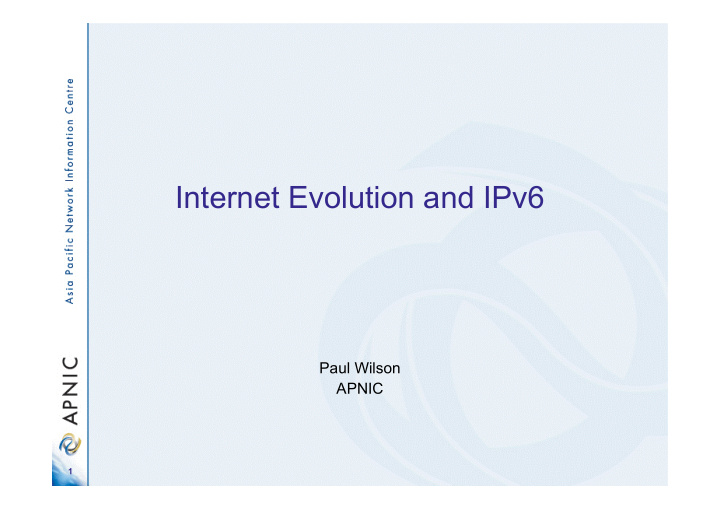



Internet Evolution and IPv6 Paul Wilson APNIC 1
Where are IPv6 addresses today? 2
IPv6 – Global allocations by RIR APNIC 337 21% RIPENCC 737 45% ARIN 438 LACNIC AFRINIC 27% 87 37 5% 2% Unit: IPv6 pref i x 3
IPv6 – Global allocations by CC CA CH SE 39 37 IT NL FR KR 33 TW GB 39 59 45 45 28 JP 95 99 AT DE 27 118 Other 581 US 391 Unit: IPv6 pref i x 4
IPv6 – Global allocations by CC AU JP 8206 7275 15% 13% FR EU 8233 6157 15% 11% KR 5191 9% DE 9580 IT TW Other PL 17% 4131 2309 2936 2088 7% 4% 5% 4% Unit: 3 2 pref i x 5
IPv6 – Global allocation growth 180 160 140 120 apnic arin 100 lacnic 80 ripencc afrinic 60 40 20 0 1999 2000 2001 2002 2003 2004 2005 2006 2007 Unit: IPv6 pref i x 6
Where is IPv6 being used today? 7
IPv6 – routed prefixes 8 http://bgp.potaroo.net/v6 /as6 4 4 7
IPv4 – routed prefixes 9 http://bgp.potaroo.net/as2 .0 /bgp-active.htm l
IPv6 – routed ASNs 10 http://bgp.potaroo.net/v6 /as6 4 4 7
IPv4 – routed ASNs 11 http://bgp.potaroo.net/as1 2 2 1 /bgp-active.htm l
Those graphs again… IPv4 IPv6 IPv6 ASN IPv4 ASN 12
The InterNAT today 13
The InterNAT Today • Everything now engineered for NAT – Client-initiated transactions – Application-layer identities – Server agents for multi-party rendezvous – Multi-party shared NAT state • Who bears the cost? – End users buy the NATs – Applications developers do the hard work – ISP costs are externalised • Seems to work! 14
Where is the ISP Industry? • Telco consolidation… – Intense competition in the ISP industry has finished – The focus has shifted away from the ISP and away carriage services and towards to content services • Commoditization… – Mass market access deployment has marginal rates of return on capital – ISP products remain undifferentiated – triple play, NGN and IMS based products have so far failed to achieve visible takeup • Stasis… – Low margins and poor capital return have created a sluggish industry that is unresponsive to change – Resistive to efforts to evolve the IP level service model 15
So what’s the problem? 16
The problem is reality • Technical – IPv6 is stable and well tested – But many technical issues are still being debated… • “The perfect is the enemy of the good” – Industry needs confidence and certainty • Business – NAT has worked too well – Existing industry based on externalizing the costs for address scarcity, and insecurity – Lack of investor interest in more infrastructure investment • Short term interests vs long term imperatives – IPv6 promotion - too much too early? • IPv6 may be seen as “tired” and not “wired” 17
The result… • Short term business pressures support the case for further deferral of IPv6 infrastructure investment • There is insufficient linkage between the added cost, complexity and fragility of NAT- based applications and the costs of infrastructure deployment of IPv6 • An evolutionary adoption seems unlikely in today’s environment – …or in the foreseeable future 18
The IPv4 revolution • The 1990’s – a new world of… – Cheaper switching technologies – Cheaper bandwidth – Lower operational costs – The PC revolution, funded by users • The Internet boom – The dumb (and cheap) network – Technical and business innovation at the ends – Many rewards for new services and innovation 19
An IPv6 revolution… • The 2000’s – a new world of… – Commodity Internet provision, lean and mean – Massive reduction in cost of consumer electronics – A network-ready society • The IPv6 boom? – “Internet for Everything” – Serving the communications requirements of a device- dense world – Device population some 2–3 orders of magnitude larger than today’s Internet – Service costs must be cheaper by 2-3 orders of magnitude – per packet 20
IPv6 – From PC to iPOD to iPOT • A world of billions of chattering devices • Or even trillions… 21
In conclusion… 22
The IPv6 Challenge • There are still too few compelling feature or revenue levers in IPv6 to drive new investments in existing service platforms • But the silicon industry has made the shift from value to volume years ago • The Internet industry might follow this lead – From value to volume in IP(v6) packets – Reducing packet transmission costs by orders of magnitude – To an IPv6 Internet embracing a world of trillions of devices – To a true utility model of service provision 23
Thank you pwilson@apnic.net 24
Recommend
More recommend